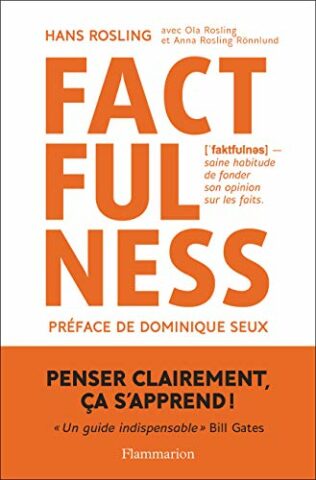Fighting fake with facts
We’ve all got a sweet tooth for a good rumor or a tale of intrigue. Yet at a time when the Internet is disgorging petabytes of false information, it’s becoming increasingly urgent to say, Basta! We must stand up to post-truths that pander to our natural appetite for sensational, sweeping statements and the blame game.
Is that an impossible dream? No! Learning how to dislodge your cognitive biases will help you develop a reality-based worldview that will be useful in both your personal and professional lives. Here’s a primer on how to start leveraging facts to overpower post-truths.

Factfulness by Hans Rosling with Ola Rosling and Anna Rosling Rönnlund (Flammarion, 2019).
1. Say no to negativity and fear
Do you tend to notice what’s going wrong rather than what’s going right? This instinct helps explain the volume of fake news based on presenting facts negatively even though there may be elements that you would normally be happy about. What’s more, when storytelling banks on spreading fear and pointing fingers, you’re even more likely to get hooked.
Strike back:
- Try to distinguish between a state (mediocre, bad, etc.) and a change (it’s better, worse, etc.). If you can identify elements in a story that are both better and worse, you’ll succumb less easily to exaggerated messages.
- Remember that good news rarely makes the front page (who’s interested in knowing that the trains are running on time?). When you find yourself being bombarded by bad news, take a step back and ask yourself whether information that was equally significant — but positive — would have been published.
- Filtering out the villains or the heroes in a story that have been identified for you in advance may help you to understand the biases in the story.
2. Don’t try to simplify everything
It is tempting to try to simplify a world that is complicated. And you can count on a very powerful cognitive bias to lead you in this direction, encouraging you to sum up every situation using binary oppositions (rich and poor, us and them, the oppressed and the oppressors, etc.).
We also tend to see every development in a linear fashion. For instance, since the world population has grown rapidly in recent years, we instinctively think that it will continue to grow at the same rate (whereas, in reality, growth has already started to slow down), which would naturally lead us to disseminate the worst possible news.
Strike back:
Don’t buy comparisons based on averages and extremes or content that talks about an unquantified “majority.” After all, there is a world of difference between a majority of 51% and 99%.
- Keep a clear head: Be wary of examples that are so striking that they could only be an exception flaunted in order to make you lose sight of the overriding rule.
- Remember that linear developments that continue over a long period are extremely rare. Most change follows a nonlinear trajectory, with bumps, slides, and S-shaped bends. If the time period you’re given only shows a straight line, enlarge the time period so you have a more global view.
3. Figure out how to change perspective
Simple ideas are irresistibly attractive because they allow us to feel we have a full grasp of a subject. When an idea has taken root — by being repeated on social networks, for example — it becomes a conviction. It may then blur your judgment, and you’ll see the world through its prism. So, if, for example, you are convinced that the world population will continue to grow exponentially, you’ll be inclined to use this belief to decipher global conflicts, migration flows, climate change, and so forth. Deeply held beliefs may also prevent you from taking into account information that does not coincide with your preconceived ideas.
Strike back:
- Do you have very strong convictions? Try to look for opposing views by seeking out people who disagree with you.
- Just because you’re expert in one subject doesn’t mean that your knowledge will serve you in every situation. You must accept that you won’t have the answers to every question.
- Be wary of arguments that are based on simple, seductive ideas that you can only agree with. And don’t forget this rule when it’s your turn to convince someone.
4. Don’t act in haste
“Let’s do it now — tomorrow will be too late!” Faced with a danger that is presented as being imminent, your instinct will drive you to react immediately. This reflex can be a life-saver — to avoid an accident while you’re driving, for instance — but counterproductive when tackling a complex problem. This sense of urgency has an unfortunate tendency to push us toward simplistic, binary opinions (good/bad) and drastic measures.
Strike back:
- Are you being urged to act quickly? Ask for more time and more information. Be firm: you must be provided with the data that justifies urgent action. Make sure that the information is relevant and reliable.
- Be wary of dramatic predictions. Consider all possible scenarios (not just the best or worst).
Don’t give in to the temptation to introduce radical measures to address an emergency — they might have unwanted side effects. Bear in mind that small steps that are concrete but limited in scope may be more effective in the long run.
© Copyright Business Digest - All rights reserved




